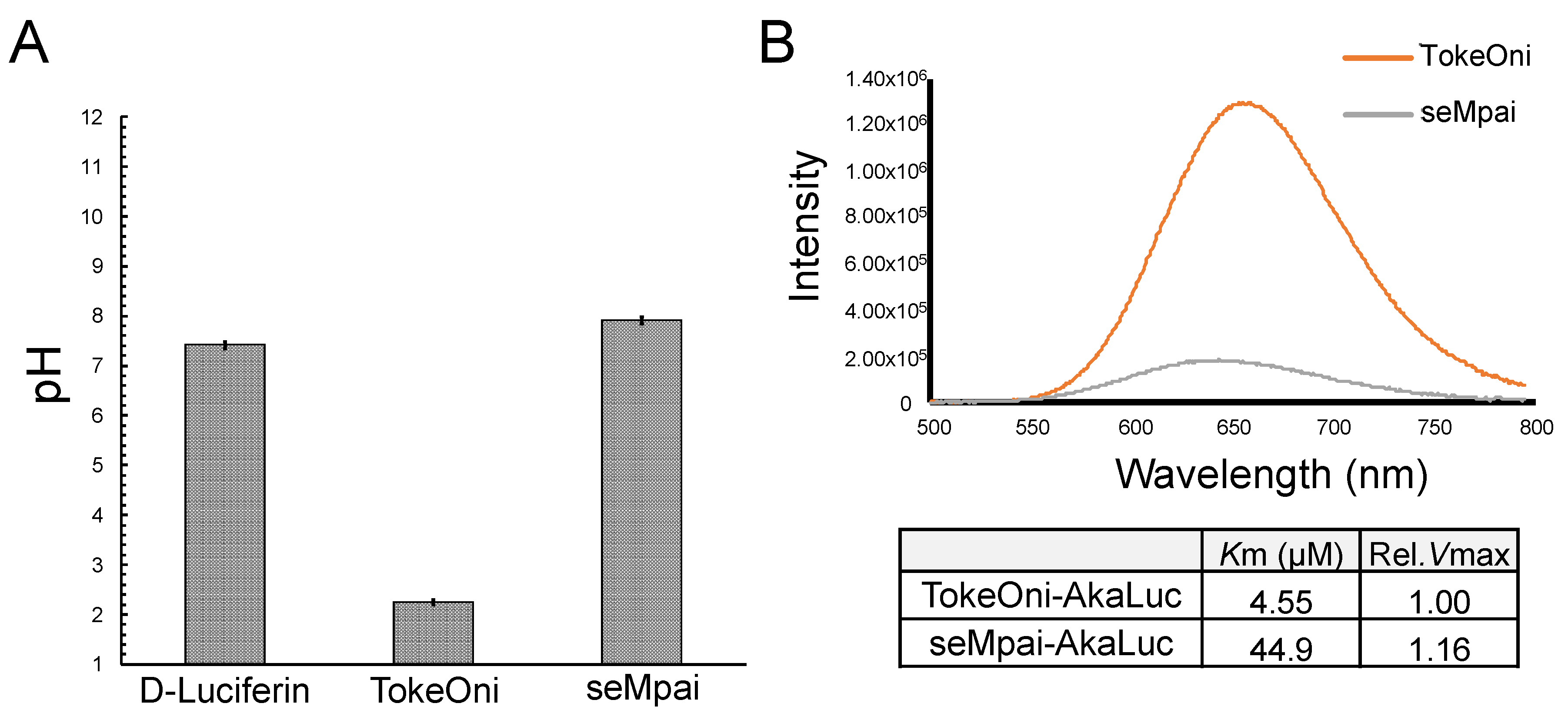High Sensitivity In Vivo Imaging of Cancer Metastasis Using a Near-Infrared Luciferin Analogue seMpai
Abstract
:1. Introduction
2. Results and Discussions
3. Materials and Methods
3.1. Synthesis of seMpai
3.2. Cell Culture
3.3. Animal Studies
3.4. pH Measurement of Luciferin Analogues
3.5. Bioluminescence Measurement of seMpai-AkaLuc Reaction
4. Conclusions
Author Contributions
Funding
Acknowledgments
Conflicts of Interest
Abbreviations
| BLI | Bioluminescence imaging |
| NIR | Near-infrared |
| Aka-BLI | AkaLumine-AkaLuc bioluminescence imaging |
| HCl | Hydrochloric acid |
| ERBB2 | Erb-b2 receptor tyrosine kinase 2 |
| PBS | Phosphate Buffered Saline |
| KPB | Potassium phosphate buffer |
| ATP | Adenosine triphosphate |
| ROI | Region of interests |
References
- Fleiss, A.; Sarkisyan, K.S. A brief review of bioluminescent systems (2019). Curr. Genet. 2019, 65, 877–882. [Google Scholar] [CrossRef] [PubMed] [Green Version]
- Alsawaftah, N.; Farooq, A.; Dhou, S.; Majdalawieh, A.F. Bioluminescence Imaging Applications in Cancer: A Comprehensive Review. IEEE Rev. Biomed. Eng. 2020, 1. [Google Scholar] [CrossRef] [PubMed]
- Yanagihara, K.; Takigahira, M.; Takeshita, F.; Komatsu, T.; Nishio, K.; Hasegawa, F.; Ochiya, T. A Photon Counting Technique for Quantitatively Evaluating Progression of Peritoneal Tumor Dissemination. Cancer Res. 2006, 66, 7532–7540. [Google Scholar] [CrossRef] [PubMed] [Green Version]
- Minn, A.J.; Gupta, G.P.; Siegel, P.M.; Bos, P.D.; Shu, W.; Giri, D.D.; Viale, A.; Olshen, A.B.; Gerald, W.L.; Massagué, J. Genes that mediate breast cancer metastasis to lung. Nature 2005, 436, 518–524. [Google Scholar] [CrossRef] [PubMed]
- Nakayama, J.; Ito, E.; Fujimoto, J.; Watanabe, S.; Semba, K. Comparative analysis of gene regulatory networks of highly metastatic breast cancer cells established by orthotopic transplantation and intra-circulation injection. Int. J. Oncol. 2017, 50, 497–504. [Google Scholar] [CrossRef] [PubMed] [Green Version]
- Han, Y.; Nakayama, J.; Hayashi, Y.; Jeong, S.; Futakuchi, M.; Ito, E.; Watanabe, S.; Semba, K. Establishment and characterization of highly osteolytic luminal breast cancer cell lines by intracaudal arterial injection. Genes Cells 2020, 25, 111–123. [Google Scholar] [CrossRef] [PubMed]
- Kuroiwa, Y.; Nakayama, J.; Adachi, C.; Inoue, T.; Watanabe, S.; Semba, K. Proliferative Classification of Intracranially Injected HER2-positive Breast Cancer Cell Lines Yuka. Cancers 2020, 12, 1811. [Google Scholar] [CrossRef] [PubMed]
- Ihara, T.; Hosokawa, Y.; Kumazawa, K.; Ishikawa, K.; Fujimoto, J.; Yamamoto, M.; Muramkami, T.; Goshima, N.; Ito, E.; Watanabe, S.; et al. An in vivo screening system to identify tumorigenic genes. Oncogene 2017, 36, 2023–2029. [Google Scholar] [CrossRef] [PubMed]
- Hall, M.P.; Woodroofe, C.C.; Wood, M.G.; Que, I.; van Root, M.; Ridwan, Y.; Shi, C.; Kirkland, T.A.; Encell, L.P.; Wood, K.V.; et al. Click beetle luciferase mutant and near infrared naphthyl-luciferins for improved bioluminescence imaging. Nat. Commun. 2018, 9, 132. [Google Scholar] [CrossRef] [PubMed]
- Kuchimaru, T.; Iwano, S.; Kiyama, M.; Mitsumata, S.; Kadonosono, T.; Niwa, H.; Maki, S.; Kizaka-Kondoh, S. A luciferin analogue generating near-infrared bioluminescence achieves highly sensitive deep-tissue imaging. Nat. Commun. 2016, 7, 11856. [Google Scholar] [CrossRef] [PubMed] [Green Version]
- Iwano, S.; Sugiyama, M.; Hama, H.; Watakabe, A.; Hasegawa, N.; Kuchimaru, T.; Tanaka, K.Z.; Takahashi, M.; Ishida, Y.; Hata, J.; et al. Single-cell bioluminescence imaging ofdeep tissue in freely moving animals. Science 2018, 359, 935–939. [Google Scholar] [CrossRef] [PubMed] [Green Version]
- Tiwari, D.K.; Tiwari, M.; Jin, T. Near-infrared fluorescent protein and bioluminescence-based probes for high-resolution in vivo optical imaging. Mater. Adv. 2020, 1, 967–987. [Google Scholar] [CrossRef]
- Fukuchi, M.; Saito, R.; Maki, S.; Hagiwara, N.; Nakajima, Y.; Mitazaki, S. Visualization of activity-regulated BDNF expression in the living mouse brain using imaging. Mol. Brain 2020, 13, 122. [Google Scholar] [CrossRef] [PubMed]
- Kitada, N.; Saito, R.; Obata, R.; Iwano, S. Development of near-infrared firefly luciferin analogue reacted with wild-type and mutant luciferases. Chirality 2020, 32, 922–931. [Google Scholar] [CrossRef] [PubMed]
- Su, Y.; Walker, J.R.; Park, Y.; Smith, T.P.; Liu, L.X.; Hall, M.P.; Labanieh, L.; Hurst, R.; Wang, D.C.; Encell, L.P.; et al. Novel NanoLuc substrates enable bright two-population bioluminescence imaging in animals. Nat. Methods 2020, 17, 852–860. [Google Scholar] [CrossRef] [PubMed]
- Lee, B.C.; Cheng, S.; Wang, Y.; Chen, Y.; Chen, N.; Souris, J.; Chen, C.; Mou, C.; Yang, C.; Lo, L. Near-Infrared Mesoporous Silica Nanoparticles for Optical Imaging: Characterization and In Vivo Biodistribution. Adv. Funct. Mater. 2009, 19, 215–222. [Google Scholar] [CrossRef]
- Saito, R.; Kuchimaru, T.; Higashi, S.; Lu, S.W.; Kiyama, M.; Iwano, S.; Hirano, T.; Kizaka-kondoh, S.; Maki, S.A. Synthesis and luminescence properties of near-infrared N -heterocyclic luciferin analogues for in vivo optical imaging. Bull. Chem. Soc. Jpn. 2019, 92, 608–618. [Google Scholar] [CrossRef]
- Matsui, A.; Fujimoto, J.; Ishikawa, K.; Ito, E.; Goshima, N.; Watanabe, S.; Semba, K. Hepatocyte nuclear factor 1 beta induces transformation and epithelial-to-mesenchymal transition. FEBS Lett. 2016, 590, 1211–1221. [Google Scholar] [CrossRef] [PubMed]



Publisher’s Note: MDPI stays neutral with regard to jurisdictional claims in published maps and institutional affiliations. |
© 2020 by the authors. Licensee MDPI, Basel, Switzerland. This article is an open access article distributed under the terms and conditions of the Creative Commons Attribution (CC BY) license (http://creativecommons.org/licenses/by/4.0/).
Share and Cite
Nakayama, J.; Saito, R.; Hayashi, Y.; Kitada, N.; Tamaki, S.; Han, Y.; Semba, K.; Maki, S.A. High Sensitivity In Vivo Imaging of Cancer Metastasis Using a Near-Infrared Luciferin Analogue seMpai. Int. J. Mol. Sci. 2020, 21, 7896. https://doi.org/10.3390/ijms21217896
Nakayama J, Saito R, Hayashi Y, Kitada N, Tamaki S, Han Y, Semba K, Maki SA. High Sensitivity In Vivo Imaging of Cancer Metastasis Using a Near-Infrared Luciferin Analogue seMpai. International Journal of Molecular Sciences. 2020; 21(21):7896. https://doi.org/10.3390/ijms21217896
Chicago/Turabian StyleNakayama, Jun, Ryohei Saito, Yusuke Hayashi, Nobuo Kitada, Shota Tamaki, Yuxuan Han, Kentaro Semba, and Shojiro A. Maki. 2020. "High Sensitivity In Vivo Imaging of Cancer Metastasis Using a Near-Infrared Luciferin Analogue seMpai" International Journal of Molecular Sciences 21, no. 21: 7896. https://doi.org/10.3390/ijms21217896
APA StyleNakayama, J., Saito, R., Hayashi, Y., Kitada, N., Tamaki, S., Han, Y., Semba, K., & Maki, S. A. (2020). High Sensitivity In Vivo Imaging of Cancer Metastasis Using a Near-Infrared Luciferin Analogue seMpai. International Journal of Molecular Sciences, 21(21), 7896. https://doi.org/10.3390/ijms21217896




